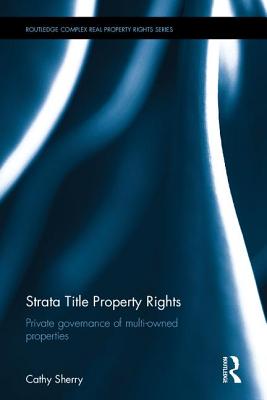Multi-owned properties make up an ever-increasing proportion of commercial, tourist and residential development, in both urban and rural landscapes around the world. This book critically analyses the legal, social and economic complexities of strata or community title schemes. The book will be of particular interest to scholars and legal practitioners of property law in Australia, but as the Australian strata title model has formed the basis for legislation in many countries, the book draws out lessons and analysis that will be of use to those studying privately-owned communities across the world.
Multi-owned properties make up an ever-increasing proportion of commercial, tourist and residential development, in both urban and rural landscapes around the world. This book critically analyses the legal, social and economic complexities of strata or community title schemes. At a time when countries such as Australia and the United States turn ever larger areas into strata title/condominiums and community title/homeowner associations, this book shows how governments, the judiciary and citizens need to better understand the ramifications of these private communities.
Whilst most strata title analysis has been technical, focusing on specific sections of legislation, this book provides higher level analysis, discussing the wider economic, social and political implications of Australia’s strata and community title law. In particular, the book argues that private by-laws, however desirable to initial parties, are often economically inefficient and socially regressive when enforced against an ever-changing group of owners. The book will be of particular interest to scholars and legal practitioners of property law in Australia, but as the Australian strata title model has formed the basis for legislation in many countries, the book draws out lessons and analysis that will be of use to those studying privately-owned communities across the world.
Get Strata Title Property Rights by at the best price and quality guranteed only at Werezi Africa largest book ecommerce store. The book was published by Taylor & Francis Ltd and it has pages. Enjoy Shopping Best Offers & Deals on books Online from Werezi - Receive at your doorstep - Fast Delivery - Secure mode of Payment
 Jacket, Women
Jacket, Women
 Woolend Jacket
Woolend Jacket
 Western denim
Western denim
 Mini Dresss
Mini Dresss
 Jacket, Women
Jacket, Women
 Woolend Jacket
Woolend Jacket
 Western denim
Western denim
 Mini Dresss
Mini Dresss
 Jacket, Women
Jacket, Women
 Woolend Jacket
Woolend Jacket
 Western denim
Western denim
 Mini Dresss
Mini Dresss
 Jacket, Women
Jacket, Women
 Woolend Jacket
Woolend Jacket
 Western denim
Western denim
 Mini Dresss
Mini Dresss
 Jacket, Women
Jacket, Women
 Woolend Jacket
Woolend Jacket
 Western denim
Western denim
 Mini Dresss
Mini Dresss






























































